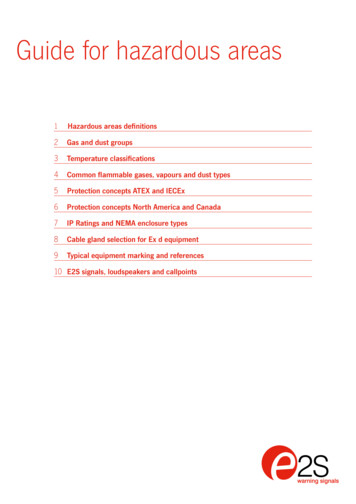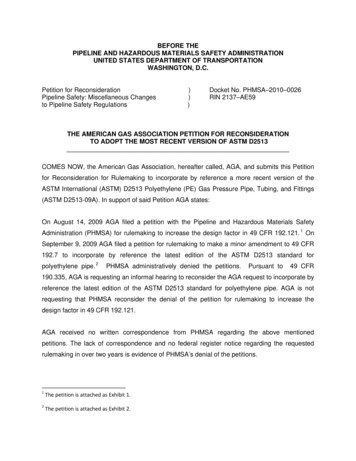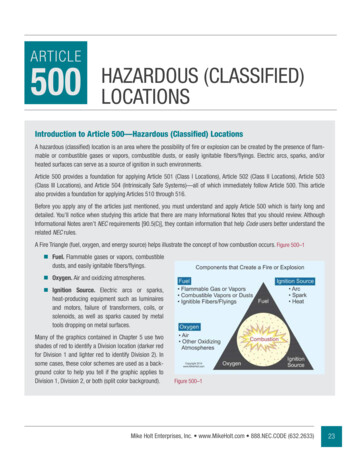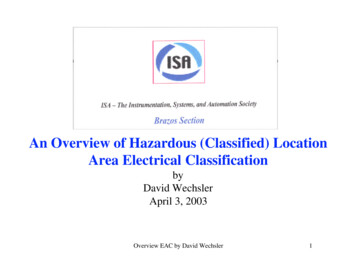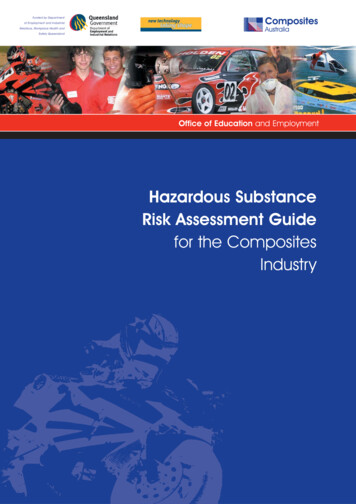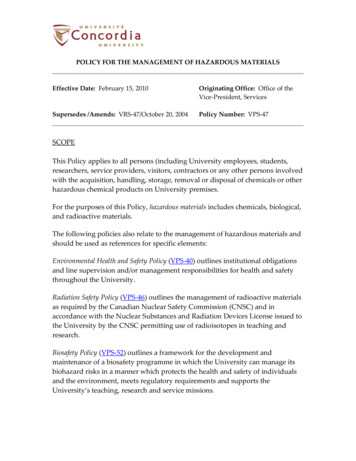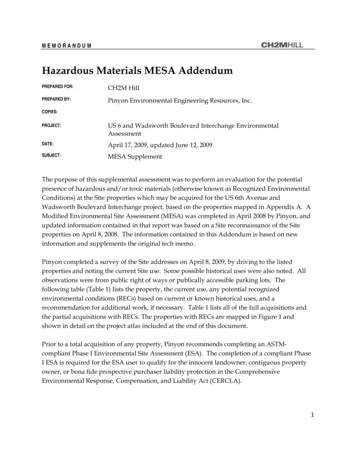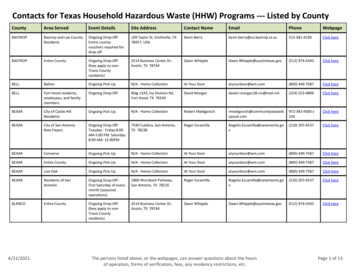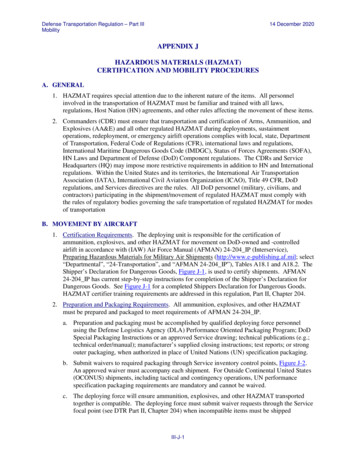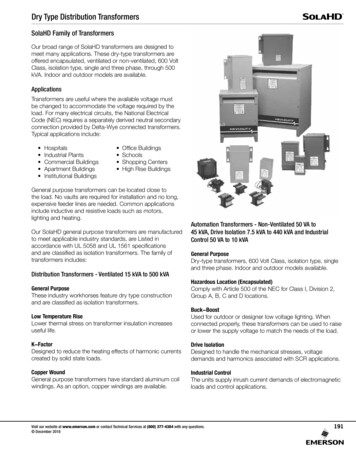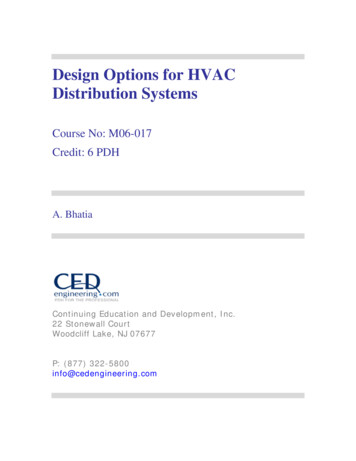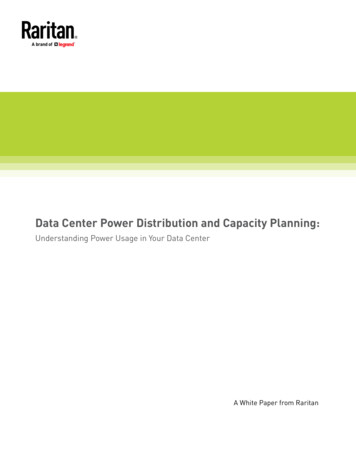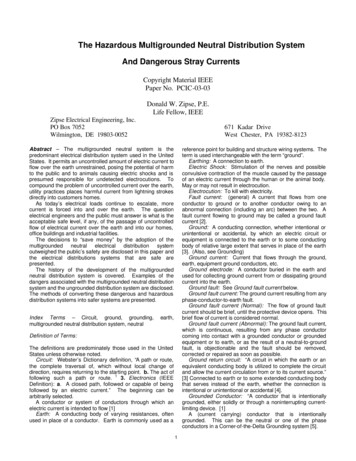
Transcription
The Hazardous Multigrounded Neutral Distribution SystemAnd Dangerous Stray CurrentsCopyright Material IEEEPaper No. PCIC-03-03Donald W. Zipse, P.E.Life Fellow, IEEEZipse Electrical Engineering, Inc.PO Box 7052Wilmington, DE 19803-0052671 Kadar DriveWest Chester, PA 19382-8123Abstract – The multigrounded neutral system is thepredominant electrical distribution system used in the UnitedStates. It permits an uncontrolled amount of electric current toflow over the earth unrestrained, posing the potential of harmto the public and to animals causing electric shocks and ispresumed responsible for undetected electrocutions. Tocompound the problem of uncontrolled current over the earth,utility practices places harmful current from lightning strokesdirectly into customers homes.As today’s electrical loads continue to escalate, morecurrent is forced into and over the earth. The questionelectrical engineers and the public must answer is what is theacceptable safe level, if any, of the passage of uncontrolledflow of electrical current over the earth and into our homes,office buildings and industrial facilities.The decisions to “save money” by the adoption of themultigrounded neutral electrical distribution systemoutweighed the public’s safety are disclosed in this paper andthe electrical distributions systems that are safe arepresented.The history of the development of the multigroundedneutral distribution system is covered. Examples of thedangers associated with the multigrounded neutral distributionsystem and the ungrounded distribution system are disclosed.The methods of converting these dangerous and hazardousdistribution systems into safer systems are presented.Index Terms – Circuit, ground, grounding,multigrounded neutral distribution system, neutralreference point for building and structure wiring systems. Theterm is used interchangeable with the term “ground”.Earthing: A connection to earth.Electric Shock: Stimulation of the nerves and possibleconvulsive contraction of the muscle caused by the passageof an electric current through the human or the animal body.May or may not result in electrocution.Electrocution: To kill with electricity.Fault current: (general) A current that flows from oneconductor to ground or to another conductor owing to anabnormal connection (including an arc) between the two. Afault current flowing to ground may be called a ground faultcurrent [2].Ground: A conducting connection, whether intentional orunintentional or accidental, by which an electric circuit orequipment is connected to the earth or to some conductingbody of relative large extent that serves in place of the earth[3]. (Also, see Grounding)Ground current: Current that flows through the ground,earth, equipment ground conductors, etc.Ground electrode: A conductor buried in the earth andused for collecting ground current from or dissipating groundcurrent into the earth.Ground fault: See Ground fault current below.Ground fault current: The ground current resulting from anyphase-conductor-to-earth fault.Ground fault current (Normal): The flow of ground faultcurrent should be brief, until the protective device opens. Thisbrief flow of current is considered normal.Ground fault current (Abnormal): The ground fault current,which is continuous, resulting from any phase conductorcoming into contact with a grounded conductor or groundedequipment or to earth, or as the result of a neutral-to-groundfault, is objectionable and the fault should be removed,corrected or repaired as soon as possible.Ground return circuit: “A circuit in which the earth or anequivalent conducting body is utilized to complete the circuitand allow the current circulation from or to its current source.”[3] Connected to earth or to some extended conducting bodythat serves instead of the earth, whether the connection isintentional or unintentional or accidental [4].Grounded Conductor: “A conductor that is intentionallygrounded, either solidly or through a noninterrupting currentlimiting device. [1]A (current carrying) conductor that is intentionallygrounded. This can be the neutral or one of the phaseconductors in a Corner-of-the-Delta Grounding system [5].earth,Definition of Terms:The definitions are predominately those used in the UnitedStates unless otherwise noted.Circuit: Webster’s Dictionary definition, “A path or route,the complete traversal of, which without local change ofdirection, requires returning to the starting point. b. The act offollowing such a path or route. 1 3. Electronics (IEEEDefinition): a. A closed path, followed or capable of beingfollowed by an electric current.” The beginning can bearbitrarily selected.A conductor or system of conductors through which anelectric current is intended to flow [1]Earth: A conducting body of varying resistances, oftenused in place of a conductor. Earth is commonly used as a1
Grounded: Connected to or in contact with earth orconnected to some extended conductive body that servesinstead of the earth. [1]The NEC definition is: “Intentionally connected to earththrough a ground connection or connections of sufficiently lowimpedance and having sufficient current-carrying capacity toprevent the buildup of voltages that may result in unduehazards to connected equipment or to persons.”Grounded, solidly: Electrical Systems. Connected directlythrough an adequate ground connection in which noimpedance has been intentionally inserted [4].Grounded system: A system of conductors in which at leastone conductor or point is intentionally grounded, either solidlyor through a noninterrupting current-limiting device. [1]Grounding: “A permanent and continuous conductive pathto the earth with sufficient ampacity to carry any fault currentliable to be imposed on it, and of a sufficiently low impedanceto limit the voltage rise above ground and to facilitate theoperation of the protective devices in the circuit.” (Note: Canbe thought of as being associated with the “green” wire whenassociated with the NEC.)Grounding conductor: A conductor that is used to connectthe equipment or the wiring system with a grounding electrodeor electrodes. [1]Normally a non-current conductor used to connectelectrical equipment or the grounded circuit of a wiring systemto a grounding electrode or electrodes. Part of the equipmentgrounding system.Grounding electrode: A buried metal water-piping system,or metal object or device buried in, or driven into the groundso as to make intimate contact. The grounding conductor isconnected to the grounding electrode. This is usually thereference connection point for a grounded wiring system [5].Multigrounded/multiple grounded system: A system ofconductors in which a neutral conductor is intentionallygrounded solidly at specified intervals. A multigrounded ormultiple grounded system may or may not be effectivelygrounded. See: effectively grounded. [1]Neutral: (IEEE Definitions) (1) (rotating machinery) The pointalong an insulated winding where the voltage is theinstantaneous average of the line terminal voltages duringnormal operation.Neutral conductor: A system conductor other than a phaseconductor that provides a return path for current to the source.Not all systems have a neutral conductor. An example is anungrounded delta system containing only three energizedphase conductors.Neutral Point: (IEEE Definitions) (2) (A) (power anddistribution transformers) The common point of a Yconnection in a polyphase system. (B) (power and distributiontransformers) The point of a symmetrical system which isnormally at zero voltage.Stray current: The uncontrolled flow of continuous electriccurrent over and through the earth.Stray voltage: An incorrect term associated with themeasurement of the voltage developed from the flow of straycurrent.System, electrical: The portion of the electrical conductors,constituting a voltage level, which exists betweentransformers, and if the last transformer, generating the lowestsystem voltage, the conductors extending from thetransformer to the load.Zipse’ Law: “In order to have and maintain a safe electricalinstallation: All continuous flowing current shall be containedwithin an insulated conductor or if a bare conductor, theconductor shall be installed on insulators, insulated fromearth, except at one place within the system and only oneplace can the neutral be connected to earth.”I.INTRODUCTIONThere is no difference between the fundamentals in lowvoltage and high voltage as Ohms Law, Kirchhoff’s Laws, etc.apply equally to each.Examples of the protective grounding used in low voltage,600-volt and below, applications will be described and used toexplain the hazards involved with the present daymultigrounded neutral distribution system, used in the UnitedStates. This will allow the reader to see the parallels betweenthe safe low voltage distribution system and the dangerousmedium voltage multigrounded neutral distribution system.There will be references to animals in this paper. Cowsand pigs are much more sensitive to electricity than humans.If animals are dying because of stray current and they are asin one case at the rate of five cows per day for over a yearuntil it was discovered that the reason was stray current, howmuch increase in electrical load will it take until the humananimal is affected? This could happen in the work place or inthe home. Reports are constantly being received by theauthor about showers, swimming pools [ 5] [6 ], and hot tubsshocking persons.The term ground will be interchanged with earth in the hopethat in the future the United States will adopt the Europeanterminology as the term earth is much more descriptive and itwill be one more step in harmonizing and unification of terms.II.HISTORYWhen Thomas Alva Edison started his electric illuminatingcompany and began the electrical distribution system, heused only one insulated (from earth) conductor and the earthfor the return conductor. He filed his patent application onFebruary 5, 1880. This uncontrolled flow of electric currentover the earth resulted in shocking horses and his employeesas they dug along side of the underground distribution system.Horse pulled traction companies’ employees working on thetracks received electric shocks, especially when separatingthe track joints.This prompted Edison to devise the three-wire distributionsystem, similar to what we use today in our homes. However,Edison insulated all three conductors. This allowed Edison toknow exactly where all the current was at all times. In his“SPECIFICATION forming part 0f Letters Patent No.389,280, dated August 30, 1887” he states on page 2, “theconductors of which are well insulated from each other andfrom the earth.” Edison goes on to give several reasonsfor not using the earth for a return conductor.Likewise, when the Underground Railway was beingdeveloped in London, they also elected to eliminate any straycurrent by using a four (4)-rail track system, two rails forsupporting and guiding the coaches, one supply rail and thereturn conductor rail. The latter two rails were insulated fromearth.2
Major debate raged over whether an electrical systemshould be connected to earth – ground. Like Edison’selectrical systems, which originally were not connected toearth, the ungrounded electrical system flourished untilapproximately 1913. In 1913, the National Fire ProtectionAssociation’s (NFPA) National Electrical Code (NEC) mademandatory the connection to earth of any electrical system of150 volts or less as measured to earth. However, when morethan one connection to earth exists on the same electricalsystem, current can flow uncontrolled over the earth, metallicpiping, equipment and through the earth causing problemswith personnel safety, electrical equipment, etc., [6], [7].Over time the utilities in the United States have failed tolearn from Edison, as today the utilities use the earth for apartial ground return path permitting the uncontrolled flow ofparallel current over not only the earth but over the adjacentunderground metallic piping and other conducting materialsresulting in damaging the health of dairy cows, reducing theirmilk output and harming humans and other animals.[6][7][8][9]III.insure adequate flow of fault current to operate theprotective device such as to blow the fuse or open thecircuit breaker.This concept of restricting electrical current flow overthe equipment grounding conductor and/or earth to onlymomentary fault current is valid for all electric circuits ofany voltage when safety is a major concern. This is trueFigure 1 Circuit diagram showing the black phaseconductor carrying current, the white neutral conductorcarrying return current and the equipment groundingconductor carrying no continuous current.THE PROBLEMIn low voltage applications, 600-volts and under for safetypurposes the NFPA’s NEC requires in residential, commercialand industrial facilities, starting approximately in the early1950s, a third wire, the equipment grounding conductor. Insome cases, the metallic conduit is used for the “equipmentgrounding conductor” However the equipment groundingconductor should be installed in each and every circuit. Thiswire was added to electrical appliances such as electric drills,heaters, washing machines, etc. The equipment groundingconductor is connected to the neutral at just one point withinthe house, at the service entrance panel. The equipmentgrounding conductor is connected to earth. However, as willbe discussed later, the neutral is also connected to earth asecond time at the transformer, which results in a parallelcircuit. The green color or bare conductor can be connectedboth intentionally and unintentionally to earth at many places,which is the object of the equipment grounding conductor.The function of the equipment-grounding conductor, thegreen or bare conductor is not to carry any continuous flowingelectric current. The key word here is “continuous.” The onlytime the equipment grounding conductor and or earth carriesany electric current is when an electrical fault occurs and thenthe object of the equipment grounding conductor is fulfilled byallowing the fault current to flow back to the source with verylittle resistance or impedance in the circuit. This allows theprotective device, such as a fuse or circuit breaker to operateand turn off the electricity thus ending quickly the hazardouselectrical fault condition.For over 50 years, the 3-wire concept has been used toinsure electrical safety in 600 volts and below electricalcircuits, which are used in homes, commercial and industrialestablishments: Phase conductor (usually black colored) carrying electriccurrent to the load or appliance Neutral conductor (usually white colored) carrying all thereturn electric current In addition, the equipment grounding conductor (usuallygreen in color) and/or earth only carrying electric currentwhen an electrical phase-to-ground fault occurs which willwhether low voltage or high voltage, whether residential,commercial or industrial wiring or electrical distributionwiring.The majority of the electrical utilities in the United Stateshave elected to save costs of electrical distributioninstallations by combining two conductor functions into oneconductor.Figure 2. Diagram showing the electrical substation with atransformer, protective device, the circuit breaker, the twoelectrical distribution conductors, the multiple connections ofthe neutral to earth and the flow of uncontrolled electriccurrent over the earth.By combining the white wire, the neutral return currentconductor carrying continuous electric current with the noncontinuous current carrying equipment grounding conductorthe utilities have saved billions and billions of dollars over 50or more years as will be shown later.The problem is that the utilities have used the earth as apartial return for the neutral current allowing the neutralcurrent to continuously flow uncontrolled over the earth, as willbe shown, which has caused irreparable and irreversible harmto dairy herds and pig farms and has caused electric shocks3
to humans andelectrocutions.mostlikelymayhaveresultedinIV. IS IT “STRAY VOLTAGE” OR“STRAY CURRENT”?Before one can fully comprehend the magnitude of theproblem one has to understand the difference between “StrayVoltage” and “Stray Current” and determine which is thecorrect term. When voltage is measured, the measurement isbetween two points.Remember Ohm’s Law which states in order to have avoltage we must have a current flowing through a resistance;Voltage Current times Resistance. Thus, it is very easy tomeasure voltage as compared to measuring current. In orderto measure current one method is to place a sensing coilaround the conductor or if possible the animal.The question that begs an answer is which is thedetermining factor, voltage or current. In order to answer thatquestion we need to look at the human animal sensitivity tovoltage and current.A. Human Sensitivity to ElectricityIt has been reported by Edward Owen, a student ofProfessor Charles F. Dalziel, University of California thatProfessor Dalziel “required” his students to participate inexperiments to measure the human animal’s response tovoltage and current by placing their feet into a bucket of saltwater and holding onto a conductor. Professor Dalziel thenapplied varying amounts of current and measured theirresponse. As recalled by the author from presentations byProfessor William B. Kouwenhoven, Electrical Engineering,Johns Hopkins University, he used fresh cadavers to measureelectric current necessary to revive the heart in order todevelop the defibrillator. These experiments and othersproduced Table 1.It has been shown that it takes approximately 35 voltsacross dry skin to force electricity into the human body. Lessvoltage or electrical pressure is required for a woman’s dryskin.As shown in the Table 1, for a 60 Hertz alternating current(ac) at 0.4 milliamps (mA) or 0.0004 Amps (A) a male will feela slight sensation on the hand. For a woman it only takes 0.3mA. A painful shock requires 9 mA for a man and for awoman 6 mA. One must note these low values.Time plays a function in the equation of electrical currentand injury. The longer a person is subjected to an electricalcurrent flow through the body, the more likely an injury willoccur.“The most damaging path for electrical current is throughthe chest cavity. In short, any prolonged exposure to 60 Hzcurrent of 20 mA or more may be fatal. Fatal ventricularfibrillation of the heart (stopping of rhythmic pumping action)can be initiated by a current flow of as little as severalmilliamperes. These injuries can cause fatalities resultingfrom either direct paralysis of the respiratory system, failure ofthe rhythmic heart pumping action, or immediate heartstoppage.” [7]It is clear that it is the current that causes a reaction inhumans, not the voltage. The voltage is the driving forceand there is a threshold below, which there is an inabilityto drive any current through the human body.Comparison of the human animal with the cow animalshows many similar conditions. Both are mammals with ablood system and both have an electrical communicationsystem, nerves.Professor Dalziel in 1946 states, “Perhaps the most seriousmisconception concerns the effects of voltage versus theeffects of current. Current and not voltage is the propercriterion of shock intensity.” [10] It is a shame the U.S.Department of Agriculture, the American Society of AgricultureEngineers and others who coined and use the term “strayvoltage” in the 1970s failed to do adequate research on thesubject.B. Measuring Electric Potential, VoltageElectric current flowing into the earth from a ground rod at apole will flow into the earth in all directions. The value ofcurrent, in amperes, can be different for various directions.The resistivity of the soil is not uniform. This is explained inthe IEEE Technical Paper titled: “Analysis of GroundingSystems in Soils with Hemispherical Layering” [11]. Thepape
Definition of Terms: The definitions are predominately those used in the United States unless otherwise noted. Circuit: Webster’s Dictionary definition, “A path or route, the complete traversal of, which without local change of
